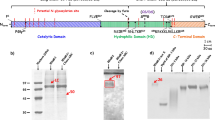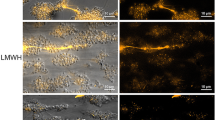Abstract
The endoglycosidase heparanase is an important in the degradation of the extracellular matrix by invading cells, notably metastatic tumor cells and migrating leukocytes. Here we report the cDNA sequence of the human platelet enzyme, which encodes a unique protein of 543 amino acids, and the identification of highly homologous sequences in activated mouse T cells and in a highly metastatic rat adenocarcinoma. Furthermore, the expression of heparanase mRNA in rat tumor cells correlates with their metastatic potential. Exhaustive studies have shown only one heparanase sequence, consistent with the idea that this enzyme is the dominant endoglucuronidase in mammalian tissues.
This is a preview of subscription content, access via your institution
Access options
Subscribe to this journal
Receive 12 print issues and online access
$209.00 per year
only $17.42 per issue
Buy this article
- Purchase on Springer Link
- Instant access to full article PDF
Prices may be subject to local taxes which are calculated during checkout






Similar content being viewed by others
References
Dietrich, C.P., Nader, H.B. & Strauss, A.J. Structural differences of heparan sulfates according to the tissue and species of origin. Biochem. Biophys. Res. Comm. 111, 865–871 (1983).
Kjellen, L. & Lindahl, U. Proteoglycans: structures and interactions. Annu. Rev. Biochem. 60, 443– 475 (1991).
Nakajima, M., Irimura, T., Di Ferrante, N. & Nicolson, G. L. Metastatic melanoma cell heparanase. Characterization of heparan sulfate degradation fragments produced by B16 melanoma endoglucuronidase. J. Biol. Chem. 259, 2283–2290 (1984).
Oosta, G. M., Favreau, L. V., Beeler, D. L. & Rosenberg, R. D. Purification and properties of human platelet heparitinase. J. Biol. Chem. 257, 11249–11255 (1982).
Hoogewerf, A. J. et al. CXC chemokines connective tissue activating peptide-III and neutrophil activating peptide-2 are heparin/heparan sulfate-degrading enzymes. J. Biol. Chem. 270, 3268– 3277 (1995).
Freeman, C. & Parish, C. R. Human platelet heparanase: purification, characterization and catalytic activity. Biochem. J. 330, 1341–1350 (1998).
Matzner, Y. et al. Degradation of heparan sulfate in the subendothelial extracellular matrix by a readily released heparanase from human neutrophils. Possible role ininvasion through basement membranes. J. Clin. Invest. 76, 1306–1313 (1985).
Sewell, R. F., Brenchley, P. E. G. & Mallick, N. P. Human mononuclear cells contain an endoglycosidase specific for heparan sulphate glycosaminoglycan demonstrable with the use of a specific solid-phase metabolically radiolabelled substrate. Biochem. J. 264, 777–783 (1989).
Naparstek, Y., Cohen, I. R., Fuks, Z. & Vlodavsky, I. Activated T lymphocytes produce a matrix-degrading heparan sulphate endoglycosidase. Nature 310, 241–243 (1984).
Bartlett, M. R., Underwood, P. A. & Parish, C. R. Comparative analysis of the ability of leucocytes, endothelial cells and platelets to degrade the subendothelial basement membrane: evidence for cytokine dependence and detection of a novel sulfatase. Immunol. Cell Biol. 73, 113–124 (1995).
Godder, K. et al. Heparanase activity in cultured endothelial cells. J. Cell. Physiol. 148, 274–280 (1991).
Freeman, C. & Parish, C.R. A rapid quantitative assay for the detection of mammalian heparanase activity. Biochem. J. 325, 229–237 (1997).
Yurchenco, P.D. & Schittny, J.C. Molecular architecture of basement membranes. FASEB J. 4, 1577– 1590 (1990).
Vlodavsky, I. et al. Expression of heparanase by platelets and circulating cells of the immune system: possible involvement in diapedesis and extravasation. Invasion Metastasis 12, 112– 127 (1992).
Bar-Ner, M., Mayer, M., Schirrmacher, V. & Vlodavsky, I. Involvement of both heparanase and plasminogen activator in lymphoma cell-mediated degradation of heparan sulfate in the the subendothelial extracellular matrix. J. Cell Biol. 128, 299– 306 (1986).
Nakajima, M., Irimura, T., Di Ferrante, D., Di Ferrante, N. & Nicolson, G. L. Heparan sulfate degradation: relation to tumor invasive and metastatic properties of mouse B16 melanoma sublines. Science 220, 611– 613 (1983).
Taipale, J. & Keski-Oji, J. Growth factors in the extracellular matrix FASEB. J. 11, 51– 59 (1997).
Ishai-Michaeli, R., Eldor, A. & Vlodavsky, I. Heparanase activity expressed by platelets, neutrophils, and lymphoma cells releases active fibroblast growth factor from extracellular matrix. Cell Regul. 1, 833– 842 (1990).
Rapraeger, A. C., Krufka, A. & Olwin, B. B. Requirement of heparan sulfate for bFGF-mediated fibroblast growth and myoblast differentiation. Science 252, 1705–1708 (1991).
Campbell, J. H., Rennick, R. E., Kalevitch, S. G. & Campbell, G. R. Heparan sulfate-degrading enzymes induce modulation of smooth muscle phenotype. Exp. Cell Res. 200, 156– 167 (1992).
Goshen, R. et al. Purification and characterization of placental heparanase and its expression by cultured cytotrophoblasts. Mol. Hum. Reprod. 2, 679–684 (1996).
Pikas, D. S., Li, J. P., Vlodavsky, I. & Lindahl, U. Substrate specificity of heparanases from human hepatoma and platelets. J. Biol. Chem. 273, 18770–18777 (1998).
De Vouge, M.W. et al. Immunoselection of grp94/endoplasmin from a KNRK cell-specific lgt11 library using antibodies directed against a putative heparanase amino-terminal peptide. Int. J. Cancer 56, 286– 294 (1994).
Graham, L. Tumor rejection antigens of the hsp90 family (gp96) closely resemble tumor-associated heparanase enzymes. Biochem J. 301, 917– 918 (1994).
Rechter, M. et al. A cellulose-binding domain fused recombinant human T cell connective tissue activating peptide-III manifests heparanase activity. Biochem. Biophys. Res. Comm. 255, 657– 662 (1999).
Gonzalez-Stawinska, G.V., Parker, W., Holzknecht, Z.E., Huber, N. & Platt, J.L. Partial sequence of human platelet heparitinase and evidence of its ability to polymerize. Biochim. Biophys. Acta 1429, 431–438 (1999).
Laskov, R., Michaeli, R.I., Sharir, H., Yefenof, E. & Vlodavsky, I. Production of heparanase by normal and neoplastic murine B-lymphocytes. Int. J. Cancer 47, 92–98 (1991).
Nakajima, M., Irimura, T. & Nicolson, G. L. Heparanases and tumor metastasis. J. Cell. Biochem. 36, 157–167 (1988).
Ricoveri, W. & Cappelletti, R. Heparan sulfate endoglycosidase and metastatic potential in murine fibrosarcoma and melanoma. Cancer Res. 46, 3855–3861 (1986).
Godavarti, R. & Sasisekharan, R. A. Comparative analysis of the primary sequences and characteristics of heparinases I, II, and III from Flavobacterium heparinum. Biochem. Biophys. Res. Comm. 229, 770–770 (1996).
Desai, U. R., Wang, H-M. & Linhardt, R. J. Substrate specificity of the heparin lyases from Flavobacterium heparinum. Arch. Biochem. Biophys. 306, 461–468 (1993).
Ernst, S., Langer, R., Cooney, C. L. & Sasisekharan, R. Enzymatic degradation of glycosaminoglycans. Crit. Rev. Biochem. Mol. Biol. 30, 387–444 (1995).
Parish, C.R. et al. Treatment of central nervous system inflammation with inhibitors of basement membrane degradation. Immunol. Cell Biol. 76, 104–113 (1998).
Willenborg, D.O. & Parish, C.R. Inhibition of allergic encephalomyelitis in rats by treatment with sulfated polysaccharides. J. Immunol. 140, 3401– 3405 (1988).
Vlodavsky, I. et al. Inhibition of tumor metastasis by heparanase inhibiting species of heparin. Invasion Metastasis 14, 290– 302 (1994-95).
Hershkoviz, R., Mor, F., Miao, H.Q., Vlodavsky, I. & Lider, O. Differential effects of polysulfated polysaccharide on experimental encephalomyelitis, proliferation of autoimmune T cells, and inhibition of heparanase activity. J. Autoimmun. 8, 741–750 (1995).
Parish, C.R., Freeman, C., Brown, K.J., Francis, D.J. & Cowden, W.B. Identification of sulfated oligosaccharide-based inhibitors of tumor growth and metastasis using novel in vitro assays for angiogenesis and heparanase activity. Cancer Res. submitted. (1999).
Lider, O. et al. Suppression of experimental autoimmune diseases and prolongation of allograft survival by treatment of animals with low doses of heparins. J. Clin. Invest. 83, 752– 756 (1989).
Hellman, U., Wernstedt, C., Gonez, J. & Heldin, C.H. Improvement of an "In-Gel" digestion procedure for the micropreparation of internal protein fragments for amino acid sequencing. Anal. Biochem. 224, 451–455 (1995).
Messer, M., Griffiths, M., Rismiller, P.D. & Shaw, D.C. Lactose synthesis in a monotreme, the echidna (Tachyglossus aculeatus): isolation and amino acid sequence of echidna alpha-lactalbumin. Comp. Biochem. Physiol. B Biochem. Mol. Biol. 118, 403– 410 (1997).
Sambrook, J., Fritsch, E.F. & Maniatis T. Molecular cloning. A laboratory manual 2nd ed. (Cold Spring Harbor Laboratory, Cold Spring Harbor, New York, 1989).
Parish, C.R., Jakobsen, K.B. & Coombe, D.R. A basement-membrane permeability assay which correlates with the metastatic potential of tumor cells. Int. J. Cancer 52, 378–383 (1992).
Horton, R. M., Hunt, H. D., Ho, S. N., Pullen, J. K. & Pease, L. R. Engineering hybrid genes without the use of restriction enzymes: gene splicing by overlap extension. Gene 77, 61–68 (1989).
Seed, B. & Aruffo, A. Molecular cloning of the CD2 antigen, the T-cell erythrocyte receptor, by a rapid immunoselective procedure. Proc. Natl. Acad. Sci. USA 84, 3365– 3369 (1987).
Acknowledgements
We thank A. Browne, K. Jakobson and E. Pagler for technical assistance and P. Milburn for the amino-acid sequencing. This research was funded by Progen Industries, Brisbane, Australia.
Author information
Authors and Affiliations
Corresponding author
Rights and permissions
About this article
Cite this article
Hulett, M., Freeman, C., Hamdorf, B. et al. Cloning of mammalian heparanase, an important enzyme in tumor invasion and metastasis. Nat Med 5, 803–809 (1999). https://doi.org/10.1038/10525
Received:
Accepted:
Issue Date:
DOI: https://doi.org/10.1038/10525
This article is cited by
-
Heparanase and the hallmarks of cancer
Journal of Translational Medicine (2020)



